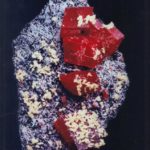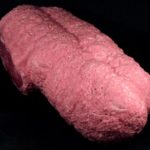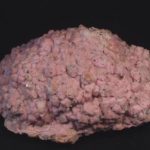Among our many Exhibits in the Rice Northwest Rock and Mineral Museum is our popular Rhodochrosite specimens. Rhodochrosite is also known as Inca Rose Stone, Raspberry Spar, and Manganese Spar.
Rhodochrosite is a manganese carbonate (MnCO3). The carbonates are a group of minerals that contain the anion group CO32-, and are subdivided into the calcite, aragonite, dolomite or hydrated carbonate subgroups. Rhodochrosite belongs to the calcite subgroup. These carbonates are known for having rhombohedral symmetry, which results in the formation of rare rhombohedron shaped crystals.
The name rhodochrosite is derived from the Greek for rose-colored. Rhodochrosite is most commonly pink or red, but may sometimes occur as yellow, grey or brown crystals. Pink and red colors occur when the rhodochrosite has a high manganese content, but some substitution of iron in place of manganese causes other colors. Its density also depends on the amount of manganese present, with a lower density associated with low iron content.
Rhodochrosite is white when powdered (white streak), and has a vitreous luster. It has similar hardness to other carbonates, with a Mohs value between 3.5 and 4. It is found most commonly in hydrothermal veins, and is associated with other carbonates, sulfide minerals, fluorite, barite and quartz.
The Incas of Columbia called it Inca Rose and believed rhodochrosite is the blood of their former kings and queens that was turned to stone.
Good crystals of rhodochrosite are valued by mineral collectors, and rare, red, rhombohedron crystals are prized most highly. The Sweet Home Mine in Alma, Colorado, produced a number of exceptional rhodochrosite crystals in the 1990s, and the reason it is the state mineral for Colorado.
The most famous of these were the Alma King and the Alma Rose. Richard and Helen Rice bought both the Alma King and Alma Rose at the Tucson Gem and Mineral Show in 1993. They sold the Alma King to the Coors Brewing Company, who subsequently facilitated the Denver Museum of Nature and Science to acquire and display the specimen.
The Rices kept the Alma Rose, one of the museums signature specimens. You can see it in the Main Gallery at the museum today. It consists of five large (~9 cm) rhodochrosite rhombohedron crystals on a matrix of quartz, calcite, sphalerite and tetrahedrite.
Make sure you see the Alma Rose and our other rhodochrosite specimens, and take a few minutes to watch the movie about the Sweet Home Mine next time you visit the museum.
For more information on rhodochrosite:
- Rhodochrosite – Wikipedia
- Rhodochrosite – Hyperphysics – Department of Physics and Astronomy at Georgia State University
- Rhodochrosite Mineral Data – Web Mineral
- Rhodochrosite – Facts, Lore, History, Myths and Pictures – Bernadine
- rhodochrosite (mineral) — Encyclopedia Britannica
- Rhodochrosite, Sweet Home Mine, Colorado – Buena Vista Gem Works
- Rhodochrosite (Manganese Carbonate) – Galleries.com
- About Rhodochrosite – Gem Select
- Rhodochrosite: Rhodochrosite mineral information and data
- Rhodochrosite: The mineral Rhodochrosite information and pictures
- Colorado State Mineral – Rhodochrosite – State Symbols USA




